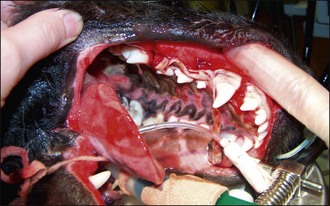30 Toxicological emergencies
Approach to the Poisoned Patient
Telephone communication
Initial telephone communication is perhaps no more important than in the intoxicated patient. The important questions to ask are summarized in Box 30.1.
BOX 30.1 Important questions to ask owners ringing with respect to intoxication
Nursing Aspect
Nurses are frequently the first members of staff with whom owners ringing about suspected or witnessed poisoning will communicate. It is therefore imperative that all nurses are well rehearsed in the questions that are important to ask (Box 30.1) and advice should be sought from the veterinary surgeon if there is any concern.
Further information
The purpose of seeking additional information about the poison in question is to ascertain if possible the severity of exposure that has or may have occurred (see Box 30.2).
Some information that may be useful when calculating exposure dosages is presented in Box 30.3.
Home management
Inducing emesis at home
In some cases in which poison ingestion has occurred within a suitable period of time, it may be appropriate for the owner to induce emesis at home, for example if financial concerns or practical constraints preclude presentation to the practice. In addition, if a considerable delay is anticipated prior to presentation, and the owner has ready access to an appropriate emetic, inducing emesis prior to departure from home may be advisable to minimize further absorption of the poison in transit. The owner must be questioned carefully to ensure that contraindications to inducing emesis do not exist; these are summarized in Box 30.4.
BOX 30.4 Contraindications to induction of emesis
Agents that may be used to induce emesis at home are shown in Table 30.1.
Table 30.1 Agents for inducing emesis at home
| Agent | Dose | Comments |
|---|---|---|
| Soda crystals (washing soda) | 1 crystal | |
| Syrup of ipecacuanha (7%) | D: 1–2 ml/kg p.o. C: 3.3 ml/kg p.o. | |
| Hydrogen peroxide (3%) | D, C: 1–3 ml/kg | |
| Table salt (sodium chloride) | Not recommended |
C, cats; D, dogs.
Clinical Tip
General Clinical Approach
History
Clinical Tip
All the information in Boxes 30.1 and 30.2 should be obtained at the appropriate time. In some emergency patients, clinical signs and progression are compatible with possible intoxication without an immediately suggestive history. In such cases, the owner must be carefully and thoroughly questioned to establish whether a potential source of poison exists that the owner has not considered.
Initial management of ingested poisons
As for all emergency patients, a major body system (cardiovascular, respiratory, neurological) examination (see Ch. 1), including measurement of rectal temperature, should be performed and immediate measures taken to correct potentially life-threatening problems. Intravenous fluid therapy (see Ch. 4) may be required to correct hypovolaemia and/or dehydration. Fluid therapy is also indicated in the management of poisons that are nephrotoxic (e.g. nonsteroidal antiinflammatory agents) and those that are largely dependent on renal excretion. Oxygen supplementation is indicated in patients with respiratory compromise, for example from aspiration following vomiting, and in the context of certain poisons such as carbon monoxide.
Emergency database
An emergency database (see Ch. 3) for the intoxicated patient should consist of the following if possible:
Treatment of seizures and muscle tremors
A variety of poisons include neurotoxicity amongst their mechanisms of action – examples include metaldehyde, pyrethroids, strychnine, caffeine, theobromine, organophosphates and tremorogenic mycotoxins. Seizures and/or muscle tremors are common signs of poisoning requiring symptomatic treatment (see Ch. 24).
Hyperthermia is a potentially serious development in patients suffering from seizures or muscle tremors. Hypothermia may also occur following bathing or sedation. Close monitoring of rectal temperature for either development and appropriate intervention (see Chs 16 and 17) is therefore required.
Gastrointestinal decontamination (GID)
Gastric emptying
In the absence of contraindications (see Box 30.4), induction of emesis is the most expeditious means to empty the stomach; feeding a small meal first may increase the effectiveness of this approach. The author has performed gastric emptying up to 4–6 hours following ingestion with some good results. Drugs used to induce emesis are summarized in Table 30.2.
Table 30.2 Drugs used to induce emesis
| Drug | Dose | Comments |
|---|---|---|
| Apomorphine | D: 0.04–0.1 mg/kg s.c., i.m., ocular | |
| C: 0.01–0.02 mg/kg s.c., i.m. | ||
| Medetomidine | C: 20 µg/kg i.m., i.v. | |
| Xylazine | C: 0.4–0.5 mg/kg i.m., s.c. |
C, cats; CNS, central nervous system; D, dogs; i.m., intramuscular; i.v., intravenous; s.c., subcutaneous.
Gastric and colorectal lavage
In patients in which induction of emesis is contraindicated or unsuccessful, gastric lavage may be appropriate for gastric emptying (see p. 296). However, it is contraindicated following ingestion of caustic or corrosive substances and where the risks of general anaesthesia are considered unacceptable.
Specific Poisons
Pyrethrins and pyrethroids
Theory refresher
Clinical Tip
Case example 1
Clinical Tip
Metaldehyde
Theory refresher
Metaldehyde is a cyclic tetramer of acetaldehyde that is commonly used as a pesticide against slugs and snails (molluscicide). Commercial pellet preparations usually contain 1.5–8% metaldehyde w/w (see Box 30.3) in a cereal base. The pellets are often blue or green in colour and the cereals and other additives make slug/snail baits palatable to dogs. Cats as usual are more discerning and metaldehyde poisoning has only been reported in a few cases. Liquid preparations containing higher concentrations of metaldehyde are also available, as are granular and powdered preparations. Metaldehyde baits sometimes contain additional herbicides and pesticides, most commonly carbamate insecticides.
Case example 2
Clinical Tip
Case management
Clinical Tip
Stay updated, free articles. Join our Telegram channel

Full access? Get Clinical Tree



